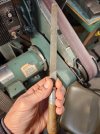A small, fine, flat file would be good. A popsicle stick and fine sandpaper would also work but be careful not to get grit down in the joint. I think the best position would be to file it when the blade is closed, or if you have a vise at the half stop with the blade (wrapped in cloth) pointing down in the vise. I know there's not much room in either position so be careful not to hit the handles. You want to file perpendicular to the blade back. Remember you're not hogging off material, just one or two short one inch swipes and then check until you're comfortable with what's coming off. Those two swipes might be all you need.
Eric
ea42 - Maybe you could use the second picture to tell the OP what part of the blade you are referencing.

